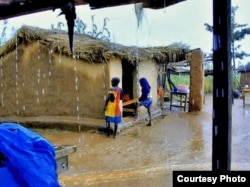Our climate is changing. And it is having significant effects on the world around us. From threats of extinction for many species to cities submerged in rising ocean waters, there are many concerns. But one important effect often gets lost in discussions of climate change’s impact: disease transmission.
A new study, in Nature Climate Change, models the long-term effects of climate change on malaria transmission in West Africa. And for once, the results aren’t all bad.
A necessary evil
In West Africa, subsistence farming relies on the regional monsoons. These heavy rains, combined with the flat landscape, also provide female mosquitoes ample puddles where they can lay their eggs. The temperatures are also just right for the mosquitoes to live a full life -- two months during which they can bite people and pass on parasites, including the plasmodium parasite which causes malaria.
The location of water pools after monsoons is the driving process for malaria transmission in West Africa. Arne Bomblies, now an associate professor at the University of Vermont, painstakingly measured the temperature, location and size of these pools during his graduate work, enduring the heat and the nausea associated with malaria prevention pills.
For her graduate work, Teresa Yamana incorporated Bomblies’ hydrological data into models that combined the best West African climate predictions, mosquito behaviors and detailed information about the land.
“We really look into a lot of detail. It’s not just amount of rainfall that matters it’s when it happens and what is the pattern of rainfall and how do these relate to the specific water pools that mosquitos need to breed,” Yamana, now a postdoctoral researcher at Columbia University, tells VOA.
Most models that look at the climate effects on malaria transmission do not take into account the water pooling characteristics of the regions. They also mostly focus on the short term effects over a decade or so. The model Yamana developed predicted the burden fifty years from now.
And the results were optimistic. The combination of temperatures warming to levels higher than those beneficial to mosquitoes and lower amounts of predicted rainfall act to maintain or decrease the malaria burden in West Africa.
Determining the malaria burden elsewhere
Bomblies and Yamana both hope that this process of including the hydrological characteristics of a region into malaria transmission models will be used elsewhere, although they note that the models cannot be used ‘as is’. They would need to be adapted to the terrain, mosquito ecology and hydrology of the region of interest. And this would be complicated for regions such as East Africa.
Malaria burden is of particular concern in East Africa. The worry is that rising temperatures will cause malaria to spread into regions where previously, it was too cold for mosquitoes to breed. Andrew Githeko, a research scientist at the Kenya Medical Research Institute in Nairobi, tells VOA that the complicated topography of East Africa would require a significant change to the models before they could be used in this region.
Andy Morse is a professor of climate impacts in the School of Environmental Sciences at the University of Liverpool. He stressed to VOA that this study predicts a reduction in the malaria burden in West Africa over the next 50 years, a much longer period of time than most studies. So he says regional authorities should still continue their attempts to control and prevent malaria transmission.
Although the long-term outlook appears optimistic, Yamana and Bomblies point out that climate change will have many other impacts on the region.
Bomblies notes that food scarcity is the utmost concern of people in West Africa. During his fieldwork, a serious famine caused a food shock there. This illustrated to him just how vulnerable the people of West Africa are to these changes in rainfall, which his models predict are going to decrease in the future.
“While it might be sort of good news that malaria isn’t going to get worse in West Africa,” he cautions, “it by no means, means that there’s going to be no issue with climate change in West Africa.”






